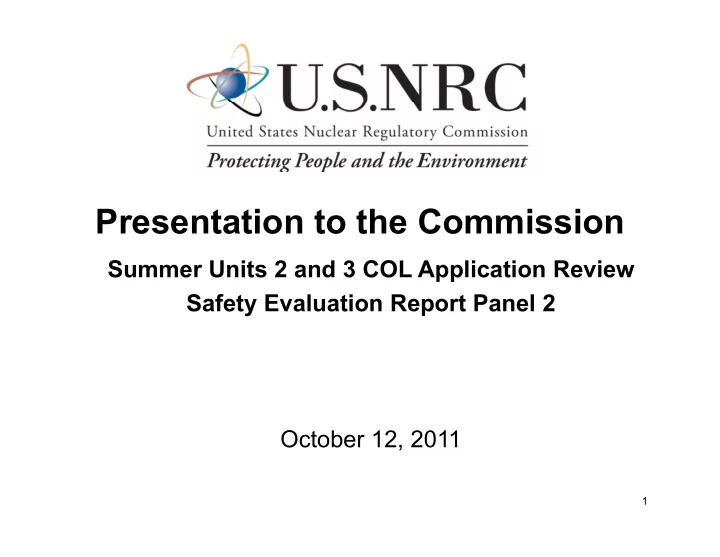

Presentation to the Commission Summer Units 2 and 3 COL Application Review Safety Evaluation Report Panel 2 y p October 12, 2011 1 NRC000010
FSAR Section 2.4: Major Hydrologic Surface Water Features Monticello Reservoir PMF Pool Elevation Monticello Reservoir Max O Operating Pool Elevation ti P l El ti Site Grade (400 ft) & Local Intense Precipitation Peak Elevation (399.4 ft) ( ) Embankment Breach Peak Flood Elevation in Mayo Creek Hypothetical Upstream Dam Breach Peak Elevation at Parr Shoals Reservoir Parr Shoals Max Operating Pool Elevation 2
FSAR Sections 2.4.12 and 2.4.13 Bounding Set of Plausible Pathways Conceptual Model for Groundwater Flow for Accidental Effluent Release Analysis for Accidental Effluent Release Analysis in the Piedmont Physiographic Province Western Pathways to Parr/Broad River Unit 2 Shallow circulation and Radial Flow from discharge to nearby water Hilltop bodies bodies Unit 3 Unit 3 Eastern Pathways to Hypothetical Private Well on Site Boundary From USGS Groundwater Atlas of U S From USGS Groundwater Atlas of U.S., 1990 1990 Eastern Pathways Surficial Soils and Less Permeable to Mayo Creek and Weathered Shallow Deep Bedrock Unit into Broad River Bedrock (about 30 feet (Saprolite/Shallow (S lit /Sh ll b beneath final site th fi l it Bedrock Unit) grade) Potential Pathway 3 Release Point
2.5.1 – Basic Geologic and Seismic Information Potential Quaternary Features in the VCSNS Site Region ( AFSER ote t a Quate a y eatu es t e CS S S te eg o ( S Figure 2.5.1-2 after FSAR Figure 2.5.1-215) 4
2.5.3 Surface Faulting V. C. Summer Site Vicinity Tectonic Features Map (AFSER Figure 2.5.3-1 after FSAR Figure 2 5 1 212) Figure 2.5.1-212) 5
2.5.3 Surface Faulting Weathered metasedimentary unit (mudstone) Weathered igneous intrusive (diorite) with quartz veins Exposure of the Wateree Creek fault (206-144 Ma in age), located 3 km (2 mi) south of the VCSNS site 6
2.5.1 Basic Geologic and Seismic Information • Geologic mapping of the Unit 2 excavation to assess • Geologic mapping of the Unit 2 excavation to assess the presence of tectonic features – In August 2010 and April 2011 the staff directly examined geologic In August 2010 and April 2011, the staff directly examined geologic features being mapped by the applicant in the Unit 2 excavation to ensure that no capable tectonic structures existed therein. – Based on direct examination the staff found the FSAR descriptions of Based on direct examination the staff found the FSAR descriptions of the geology to be consistent with field observations and that no capable tectonic structures, or other potentially detrimental geologic features, occur in the Unit 2 excavation – On the basis of these trips, a geologic mapping license condition is unnecessary for Summer Unit 2 – The staff proposes including the geologic mapping license condition for Summer Unit 3 pending the staff’s observations of the Unit 3 excavation 7
Chapter 2 8
Potential tectonic features were carefully examined by NRC geologists NRC geologists 9 9
Section 2.5.2–Vibratory Ground Motion Updated Charleston Seismic Source (UCSS) Model Updated Charleston Seismic Source (UCSS) Model (FSAR Figure 2.5.2-213) 10
Section 2.5.2–Vibratory Ground Motion y • Eastern Tennessee Seismic Zone (ETSZ) – The Staff requested that the applicant address new seismic source information for the ETSZ in its probabilistic seismic hazard analysis (PSHA). – SCE&G referenced a generic sensitivity study conducted in 2008 by – SCE&G referenced a generic sensitivity study conducted in 2008 by the Nuclear Energy Institute (NEI), which showed that potential changes to the seismic hazard resulting from updating the ETSZ are not significant and thus performing updates to this source zone was unnecessary. unnecessary – Staff also performed its own sensitivity calculation to determine whether the updated maximum magnitude distribution used in the NEI sensitivity study would significantly change the VC Summer y y g y g ground motion response spectra (GMRS). – Staff’s sensitivity calculation showed no significant impact to the seismic hazard for the VC Summer site. 11
Comparison of Ground Motion Response Spectra with Certified Design Response Spectra g p p • The VC Summer ground motion response spectra motion response spectra (GMRS) was compared to the certified seismic design response spectra (CSDRS) and the hard (CSDRS) d th h d rock high-frequency (HRHF) spectra • The staff concludes that The staff concludes that the high frequency seismic input was evaluated in the AP1000 DCD and considered to be non-damaging Comparison of the VC Summer GMRS with the AP1000 CSDRS and HRHF spectrum (FSAR AP1000 CSDRS and HRHF spectrum (FSAR Figure 2.0-201) 12
Seismic Margins Analysis Seismic Margins Analysis • A review-level earthquake with a peak ground q p g acceleration of 0.5g was established in the AP1000 DCD and used to demonstrate a margin over the safe- shutdown earthquake (PGA=0.3g). shutdown earthquake (PGA=0 3g) • Because the ground motion response spectra for the V.C. Summer site is bounded by the hard-rock, high- frequency spectra also analyzed in the AP1000 DCD, the staff finds that the SMA provided in the DCD bounds and demonstrates an acceptable seismic margin for V C demonstrates an acceptable seismic margin for V.C. Summer Units 2 and 3 . 13
V.C. Summer Nearby Facilities V.C. Summer Nearby Facilities From VCSNS FSAR Figures 2.2-201 & -202 Site Vicinity Map of Industrial Facilities inside a 5-Mile Radius of Units 2 and 3 Airway V53 14
V.C. Summer External Events Screening Criteria Applied External Event Negligible Negligible Bounded Not Applicable Frequency q y Consequence q Tornado • Hurricane • • 1 External flood PMP flood < 400’ (grade) Aviation • Marine No barge traffic Pipeline • Nearest pipeline >1 mi. Railroad • D closest track > D standoff Truck • Nearby facilities • E ternal fires External fires • 1 Extratropical cyclones 15
Recommend
More recommend